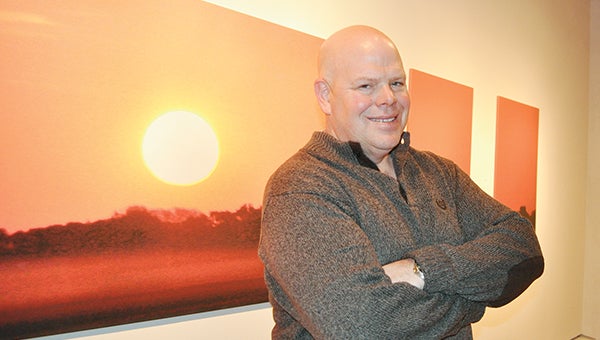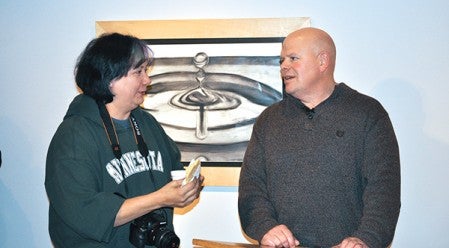From insurance to art
Published 10:10 am Thursday, November 29, 2012

Dr. Michael Grenier poses next to an untitled work in his latest exhibit at Riverland, "Natura." The exhibit closed Wednesday and Grenier gave a talk to community members about the close ties society has with nature. -- Trey Mewes/trey.mewes@austindailyherald.com
Professor shows off ‘Natura’ display
Almost every day for more than three months this summer, Dr. Michael Grenier would get up before sunrise, try not to disturb his family, and race out of the house. The Owatonna-based artist would take photos of the sky just as the sun peaked up through the trees on prairie land. One of those photos was on display on the back wall of the James Wegner Art Gallery inside Riverland Community College, surrounded by several types of art in the latest multimedia exhibit, “Natura.”

Dr. Michael Grenier, right, talks with an area resident about his work in the "Natura" exhibit after his talk Wednesday morning.
Grenier was present Wednesday morning at the exhibit on its final day to speak not only about his art, but about the need for art and the necessity of connecting with nature once in a while to recharge and heal ourselves.
“We walk by art, we drive by it every day,” Grenier told an audience of more than 20 people at the closing reception of “Natura.” “But do you really allow yourself to be a part of art?”
For Grenier, that’s an important experience. Originally in insurance, Grenier thought he would have time to make art after he retired and made his money. Yet a snowmobiling accident caused him to rethink his life, and after earning two bachelor’s degrees, two master’s degrees and finally a doctoral degree in 2009, Grenier not only makes art but teaches it at Riverland, South Central College and Augsburg College.
That’s why he felt so passionately about getting back to the outdoors, and getting away from what he calls the “toxicity” of modern-day life caused by social and civil strife.
“We kind of become insulated by some of this toxicity that we observe from the media,” he said.
With so much going so fast in our lives, Grenier took inspiration in stopping to experience some of the finer outdoor details, such as the sound of rain and thunder or the feeling of grass beneath us.
To that end, he created multiple works signifying his love of the Minnesota prairie — why travel when he can enjoy nature right here, he told the audience — using charcoal, pencil, photography and even multimedia paintings and sculptures.
“This is art about the place we live,” said Tim Jones, curator of the James Wegner Art Gallery. Wegner said he was impressed with how connected the pieces were, how they drew people toward the center of the room, simulating the centering experience Grenier hoped to convey to people.
That’s why he created pieces like a long, panoramic view of that sunrise he photographed. Spread across the wall in five pieces, the sun barely rising over the treeline brings focus to the middle acoustic tile before observers look at what else is displayed. The acoustic tiling for several pieces were made of corn and soy products, courtesy of a special mounting procedure done by a local cabinet company, J & J Cabinets.
That’s not the only piece of actual prairie materials in Grenier’s work, however. The centerpiece of the exhibit is a large sphere made of beeswax, which Grenier said represented an egg, or a seed, from which life flows. While the piece isn’t titled — Grenier never titles his work at first as he wants observers to draw their own interpretations — the sphere is supported by a pedestal of sorts made of wood, topped with a glass pane painted to resemble a body of water, followed by neon lighting surrounded by a level of clay, dirt and grass, and leading to a pile of burnt wood on the lower half of the pedestal. This work, above others, calls for observers to use many of their senses, like sight, touch, and smell, to represent the life flowing from the prairie.
“I wish the wood was burnt a little more,” he told audience members. “I wanted to really convey that smell of burnt wood.”
“Natura” may be done at the art gallery and Grenier will continue his work, but he hopes people who had the chance to see it remembers how connected we all are with nature.
“Every little thing in nature has a purpose,” he said. “Even wood ticks have some sort of a purpose.”





